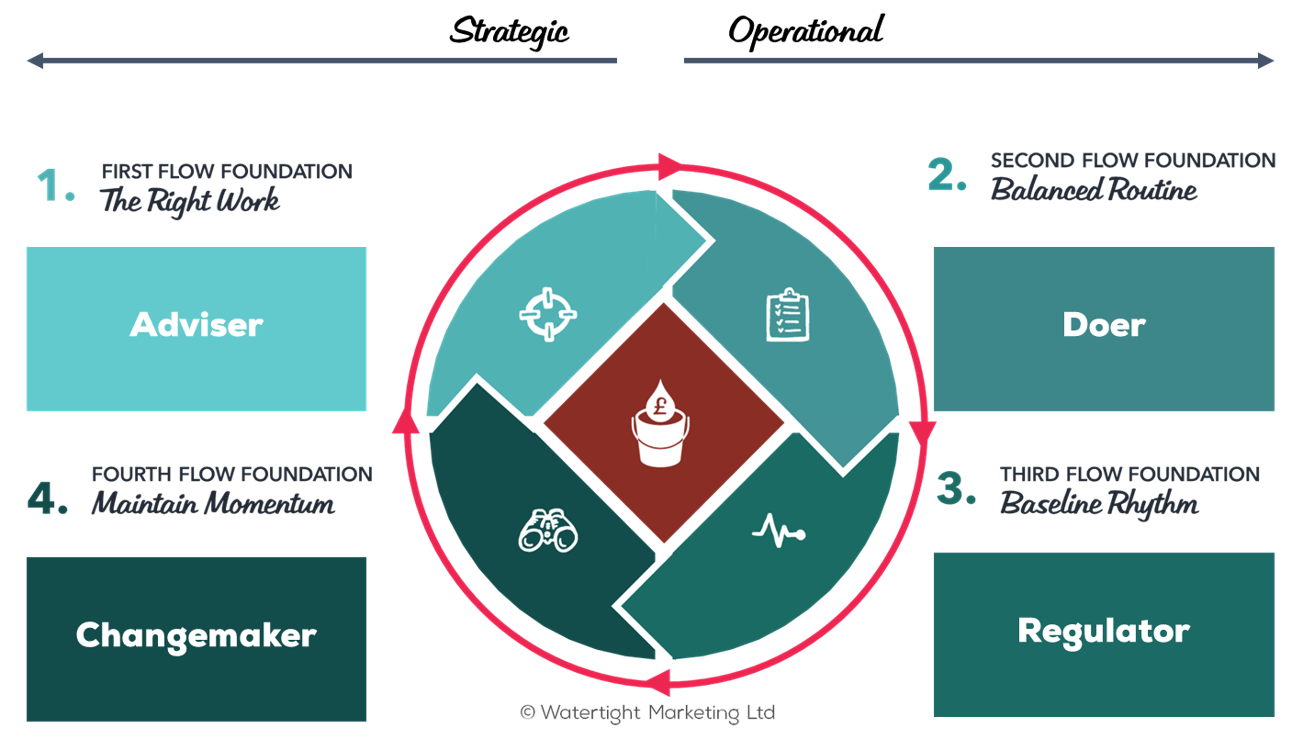Reading Time: 10 Minutes
Listen to the session podcast here
47-minute roundtable discussion on how to manage change.
One of the hats that a marketing wears is that of changemaker. This person leads our fourth Flow Foundation, where the vision, values and milestones sit. They challenge the status quo, are the innovator. They shake things up, have the difficult conversations and look at what needs to happen to move things forward.
Equally, change can happen in other areas of marketing – our first, second and third Flow Foundations. It might be external circumstances or internal factors that drive change.
For instance:
- In the first Flow Foundation (The Right Work), you might see changes in the market landscape that mean you have to re-think your ideal customers, position yourselves differently or explore alternative channels to market.
- In the second Flow Foundation (Balanced Routine), changes in technology could cause you to choose new tools to engage with your prospects and customers.
- In the third Flow Foundation, (Baseline Rhythm), you might need to make processes more efficient or bring in a new CRM/finance/business management system, which then brings up a whole load of cultural and process changes.
- In the fourth Flow Foundation, a change in CEO could easily lead to you refining your values or writing a new business plan, communication of which is something that marketing can support.

Roger Williams: “What I found when I was in marketing was that most of the change and challenges I dealt with were organisational in nature, not technical.” It’s a reminder that there’s little marketing-related change that doesn’t reach beyond the marketing function.
He added: “It’s inevitable that marketing people are advocates for change, given the nature of the job.”
Rachael Wheatley: “So part of our job is to be alert to change that is needed.”
Roger Williams: “It should be the board that sees that, but marketing people are usually more responsive to what’s happening in the environment and what changes are required. However, you’re not always chartered to bring about organisational change. All you have at your disposal, then, is advocacy.”
Why does change falter?
Here are eight common barriers to change:
- No board sponsorship: Especially important if the change involves people across the business. Lack of senior support can be the difference between success and failure.
- Not sufficiently focused on how: The end point might be clear, and why you want to move away from the current situation. However, what can be a bit opaque is how you’re going to get there, what and who’s involved, the steps and the timescale. Sometimes the how might be clear initially, but it fizzles out. Quarterly update meetings don’t happen. The project team loses momentum. And then your route to the end point is lost in the weeds.
- Distractions: These are numerous. It could be to do with a lack of focus or priority given to this project. Perhaps you have a lot on your plate and it’s hard to carve out time on top of your ‘day job’.
- Siloed working: If the culture has tended to be characterised by siloed teams, it can be a real hindrance to working collaboratively. Often the change requires teams to work together.
- Partial fixes only: You might see a problem and put in place a fix, but it might only be dealing with the symptoms rather than the root cause. That’s not to say that partial fixes can’t work – they can – but don’t be surprised if they don’t fully effect the change you’d like to see.
- Not seeing the real problem: Your starting point when faced with the need for change is really understand what the real problem is – it may not be what you think it is.
- Caught unawares: Sometimes change is forced upon you. That could be because of a crisis, or it might be because your timescale is short. In these situations, change is harder, more stressful and is fraught with hurdles.
Ruth Napier: “Change management is part and parcel of any marketing career. But you’re rarely given any learning or structures around it. There are courses available to help open up your mindset and think about innovation in a different way and give you structures around how to frame problems and get to the root of the problem rather than what might be the symptoms. The short term fixes address those symptoms but not the root problem.”
Sarah McDowall: “What’s a potential solution to problems around capacity? Often I want to change things in our organisation – could be small things – but I’m the only person in marketing so I find it quite difficult to work out how to implement change… most of which I can’t do myself.”
Rachael Wheatley: “I’d suggest two things. Firstly to focus the marketing. Spend some time deciding what marketing you need and what’s nice to have. We have a tool that can help you do that to help you prioritise. Use that to create a bit of time.”
“Then plan out the change you want to effect, share it with others so they know what you want to focus on and bring them in to the project and schedule it out.”
Roger Williams: “The way to anchor what it is you’re doing is in the context of what you trying to achieve as an organisation. Create an envelope that makes sense to others and is part of the effort to achieve shared goals. Once those goals are expressed you can make trade offs – this, not that.”
Rachael Wheatley: “So if you do find that things are piling up, say that you can do this, but not that as well; think collectively about what the priorities are.”
Roger Williams: “That also enables the conversation: now we’ve had a look at it, we’re not resourced to address the opportunity. Can we add capacity or outsource elements?”
Monserrat Cano: “Some organisations need external help to oversee the project and bring change. Even if the team is motivated, if they don’t know what they’re doing, business change won’t work.”
Roger Williams: “That’s an important point: recognise the limits of the situation, which you might not be able to fix. The onus is increasingly on marketers to foster that discussion. The recurring theme here is managing success. It’s one thing to envisage the outcome; it’s another to do the patient work of describing all the things that need to be in place to support that outcome. Individuals don’t do this – teams do this. If you can’t get the team to work, you won’t get traction on the problem.”
Alice Friday: “Be clear if there is a risk of turning something off; if there isn’t turn it off to try something different to aid your learning. Speak to stakeholders in language they understand. In a previous role I had, I inherited three social media accounts. In terms of our KPIs it was clear two of them contributed nothing. They were turned off and that gave me capacity to focus on activity bringing the most return. Set clear timelines – if we don’t see a return by this time, fail quickly and move on to something else.”
Liz Smythe: “I agree. Having clear strategic priorities helps you to focus on what needs to be done and can allow you to push back on some work that is requested to allow time to work on other projects.”
How can you ensure successful change?
To mitigate these barriers:
- Sponsor or ally: Make sure, before you start the project, that you have a senior ally and sponsor. It will need to be at board level if it’s a business-wide change or affects more than your team. At the very least, your boss. You’ll be glad of them if you end up dealing with difficult people or situations.
- Route map: In any project, you’ll need a plan, a route map, with clear steps and milestones. It makes change more feasible and tangible for people. Some people will need reassurance along the way. A route map helps with that and enables you to mark achievements and progress – and of course put in place mitigations if it’s not on course.
- Time & focus: Carve out time, plan the project and tasks as you would any marketing activity, have regular meetings – give it the focus it deserves. Decide how you’ll deal with distractions and communicate that. There is only so much you can do, so prioritise.
- Team & project: Create a team. It gives joint accountability. There’s an energy to that, too. You’ll build relationships, share the work and success. Provide regular updates to your manager, the leadership team, the board.
- Short & long-term solutions: There may well be ‘quick fixes’ to a problem and these are great to show progress. Do also consider what will be the longer term solutions as well and recognise that partial fixes won’t necessarily effect lasting change.
- Discover the real problem: Frame the challenge or problem, the solution for which involves change. There are creative problem solving techniques you can use to understand and agree the real problem.
- Be proactive: Scan the market, undertake regular landscaping and research, survey your customers and talk to them about what’s happening in their world. Consider a risk register where you’re looking at any potential risk and what you can do to mitigate it and the effect it might have.
Liz Smythe: “Having cross-department teams is really important, not only for them to give regular updates to management on how the project is going but also to other colleagues so that everyone is kept in the loop.”
Rachael Wheatley: “Yes, and what I’ve found is those cross-departmental teams are some of the best ways to get change to happen.”
“The other key thing is communication. It helps keep people on-board. You need to keep the faith – you’re communicating over months or even years and it’s beholden on us as marketers to make sure that happens.”
Roger Williams: “Typically the change management projects are nine months to 2 years. At the four month mark I stop being a change manager and I start being a continuity manager. It’s the most human of all areas to lose sight of what it was you were trying to do.”
One of the areas we explored as being important for success is the confidence the change leader has in managing change.
Jenny South: “We have a lot of people who’ve been in our organisation for more than 20, and up to 35 years versus people who’ve been here 1-5 years. People don’t proactively seek information and you can tell there’s a lack of confidence in understanding and dealing with change. We need to make it more obvious why we’re changing and what the steps are to get there.”
Rachael Wheatley: “That’s a good reason to put together a cross-department team, inviting people who have a vested interest in that change. Start off by discussing why you’re doing it and between you co-create a plan and route map. Each person has accountabilities and responsibilities. If you involve people and you communicate what you’re doing, progress and milestones to the rest of the business, they will start getting on board.
Roger Wiliams: “I strongly agree with that. This is a case of mobilisation. In a meeting you can do the what and why. What you’re trying to get at is: what do you think about this? What will come out is a whole pile of moans and grumbles and “can’t it be like it always used to be”. That is helpful in itself. Where you get to next is: what is going to stop us. That generates the start of a work plan because everything that’s going to stop you are the success factors that need to be managed.”
Jenny South: “In our organisation, people moan a lot but when asked to open up, they say nothing’s wrong.”
Rachael Wheatley: “Sounds like that, for whatever reason, they don’t feel safe to articulate how they feel. In a smaller project team you can set the engagement rules to be open and honest otherwise you won’t see positive change you want to see. You do need to tease that out. By having a team you’ll gradually improve your confidence.”
Jenny South: “The key relationship for me is sales to marketing. My key ally is in sales.”
Rachael Wheatley: “So, having that key ally on your project team will help, too.”
Dean Vale: “It’s really about getting people involved so it’s part of their vision, not just in the head of the MD. Marketing can be the conduit for creating a vision that everyone can see – staff and clients. Making others part of the change can be the tipping point. I have worked with many companies, and getting that buy-in at the start is a big part of success.”
Watertight Wisdom
What’s worked for us
We had some really useful tips from around the room. Here are eight of those nuggets:
- Be empowered by purpose and shared vision. This is the starting point for any change and will help enable it to happen.
- We not I. Successful change is a team effort and building cross-departmental teams is a good way of doing this.
- Evidence and testing. Look at what’s worked for other organisations and people, bring in external people if needed to facilitate or oversee change.
- Show results and be patient. Change often happens over a long time horizon so be patient and keep the faith. This makes regular updates, two-way communication and showing progress against milestones critical.
- Communication, communication, communication! Use clear and meaningful communication and ensure everyone involved understands the why and how.
- Consistent and supportive. Ensure the tone from the top is consistent and supportive – having that senior advocacy is essential to success.
- Stay human. Remember to account for human nature. Change is often unnerving and some people will need reassurance as well as encouragement to come on board.
- Put actions to the vision set at the highest level and focus on small steps towards the big goal.
To join the conversation at our next Watertight Wednesday marketing roundtable in October sign up here. We’ll be sharing the results of our updated research into how well marketing supports business plans. Please do take part in the research; it only takes 10 mins and you’ll be entered into our prize draw.

Rachael Wheatley
Managing Director, Watertight Thinking
Rachael brings over 30 years’ of marketing experience, with a particular focus on building and developing effective marketing teams that are able to act as a strategic driving force across an organisation. She has worked with Watertight since 2014 as a Master Practitioner and joined the business as MD in 2022.



